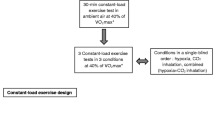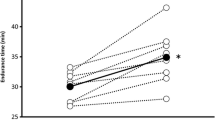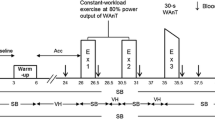Summary
It is uncertain that exercise with reduced frequency breathing (RFB) results in arterial hypoxemia. This study was designed to investigate whether RFB during exercise creates a true hypoxic condition in arterial blood by examining arterial oxygen saturation (SaO2) directly. Six subjects performed ten 30 s periods of exercise on a Monark bicycle ergometer at a work rate of 210 W alternating with 30 s rest intervals. The breath was controlled to use 1 s each for inspiration and expiration, and two trials with different breathing patterns were used; a continuous breathing (CB) trial and an RFB trial consisting of four seconds of breath-holding at functional residual capacity (FRC). Alveolar oxygen pressure during exercise showed a slight but significant (p<0.05) reduction with RFB as compared to CB. However, a marked increase in alveolar-arterial pressure difference for oxygen (A-aDO2) (p<0.05) with RFB over CB resulted in a marked (p<0.05) reduction in arterial oxygen pressure. Consequently, SaO2 fell as low as 88.8% on average. Additional examination of RFB with breath-holding at total lung capacity showed no increases in A-aDO2 in spite of the same amount of hypoventilation as compared with that at FRC. These results indicate that RFB during exercise can result in arterial hypoxemia if RFB is performed with breath-holding at FRC, this mechanism being closely related to the mechanical responses due to lung volume restriction.
Similar content being viewed by others

References
Bjertnaes L, Hauge A, Kjekshus J, Soyland E (1984) Cardiovascular responses to face immersion and apnea during steady state muscle exercise. A heart catheterization study on humans. Acta Physiol Scand 120:605–612
Counsilman JE (1977) Competitive Swimming Manual for coaches and swimmers. Counsilaman Co Inc, Indiana
Craig AB, Jr (1979) Fallacies of “Hypoxic Training” in swimming. In Terauds J, Bedingfield EW (ed) Swimming III. University Park Press, Baltimore, pp 235–239
Craig DB, Wahba HF, Don HF, Couture JG, Beckkade MR (1971) “Closing volume” and its relationship to gas exchange in seated and supine posisions. J Appl Physiol 31:717–721
Dicker SG, Lofthus GK, Thornton NW, Brooks GA (1980) Respiratory and heart rate responses to tethered controlled frequency breathing swimming. Med Sci Sports Exerc 12:20–23
Ehrsam RE, Heigenhauser GJF, Jones NL (1982) Effect of respiratory acidosis on metabolism in exercise. J Appl Physiol: Respirat Environ Exercise Physiol 53:63–69
Findley LJ, Ries AL, Tisi GM, Wagner PD (1983) Hypoxemia during apnea in normal subjects: mechanisms and impact of lung volume. J Appl Physiol: Respirat Environ Exercise Physiol 55:1777–1783
Gale GE, Torre-Bueno JR, Moon RE, Saltzman HA, Wagner PD (1985) Ventilation-perfusion inequality in normal humans during exercise at sea level and simulated altitude. J Appl Physiol 58:978–988
Graham T, Wilson BA, Sample M, Van Dijk J, Bonen A (1980) The effects of hypercapnia on metabolic responses to progressive exhaustive work. Med Sci Sports Exerc 12:278–284
Graham TE, Wilson BA, Sample M, Van Dijk J, Goslin B (1982) The effects of hypercapnia on the metabolic response to steady-state exercise. Med Sci Sports Exerc 14:286–291
Heisler N (1975) Intracellular pH isolated rat diaphragm muscle with metabolic and respiratory changes of extracellular pH. Respir Physiol 23:243–255
Hirche HJ, Hombach V, Langohr HD, Wacker U, Busse J (1975) Lactic acid permeation rate in working gastrocnemii of dogs during metabolic alkalosis and acidocis. Pflügers Arch 356:209–222
Holmer I, Gullstrand L (1980) Physiological responses to swimming with a controlled frequency of breathing. Scand J Sports Sci 2(1):1–6
Hong SK, Lin YC, Lally DA, Yim BJB, Kominami N, Hong PW, Moore TO (1971) Alveolar gas exchanges and cardiovascular functions during breath holding with air. J Appl Physiol 30:540–547
Hsieh SS, Hermiston RT (1983) The actue effects of controlled breathing swimming on glycolytic parameters. Can J Appl Sports Sci 8:149–154
Jones NL, Campbell EJM (1982) Clinical exercise testing 2nd. W. B. Saunders, Philadelphia
Kawakami Y, Natelson BH, Dubois AB (1967) Cardiovascular effects of face immersion and factors affecting diving reflex in man. J Appl Physiol 23:961–970
Lin YC, Shida KK, Hong SK (1983) Effects of hypercapnia, hypoxia, and rebreathing on circulatory response to apnea. J Appl Physiol: Respirat Environ Exercise Physiol 54:172–177
Mainwood GW, Worsley-Brown P (1975) The effects of extracellular pH and buffer concentration on the efflux of lactate from frog sartorius muscle. J Physiol 250:1–22
Piiper J, Scheid P (1981) Model for capillary-alveolar equilibration with special reference to O2 uptake in hypoxia. Respirat Physiol 46:193–208
Seo Y (1984) Effects of extracellular pH on lactate efflux from frog sartorius muscle. Am J Physiol (Cell Physiol 16) 247:C175-C181
Severinghaus JW (1979) Simple, accurate equations for human blood O2 dissociation computations. J Appl Physiol: Respirat Environ Exercise Physiol 46:599–602
Torre-Bueno JR, Wagner PD, Saltzman HA, Gale GE, Moon RE (1985) Diffusion limitation in normal humans during exercise at sea level and simulated altitude. J Appl Physiol 58:989–995
Weenig CS, Pietak S, Hickey RF, Fairley HB (1974) Relationship of preoperative closing volume to functional residual capacity and alveolar-arterial oxygen difference during anesthesia with controlled ventilation. Anesthesiol 41:3–7
Author information
Authors and Affiliations
Rights and permissions
About this article
Cite this article
Yamamoto, Y., Mutoh, Y., Kobayashi, H. et al. Effects of reduced frequency breathing on arterial hypoxemia during exercise. Europ. J. Appl. Physiol. 56, 522–527 (1987). https://doi.org/10.1007/BF00635364
Accepted:
Issue Date:
DOI: https://doi.org/10.1007/BF00635364



